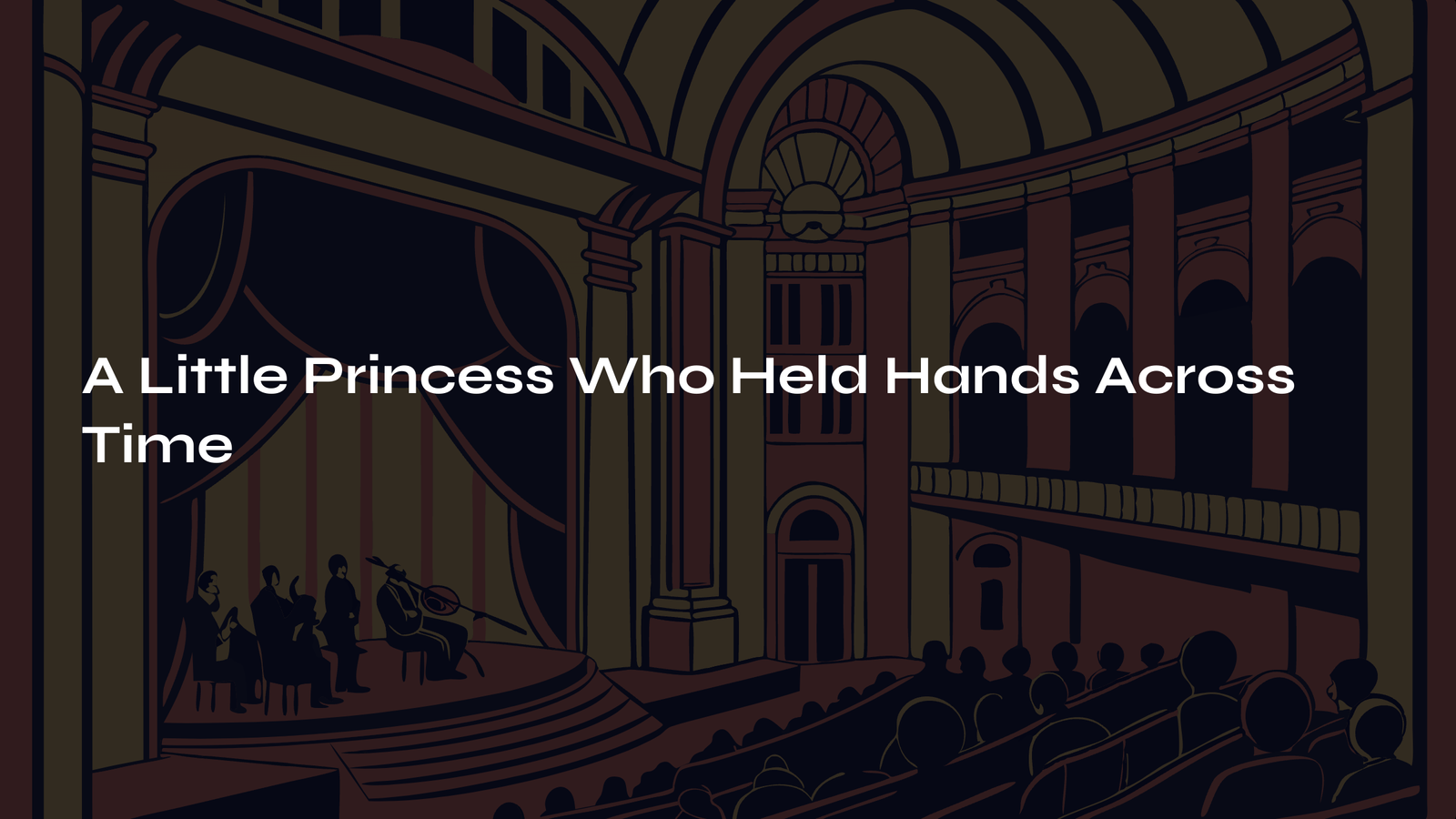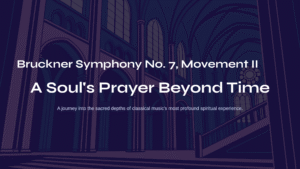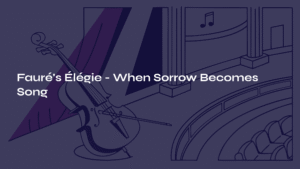Table of Contents
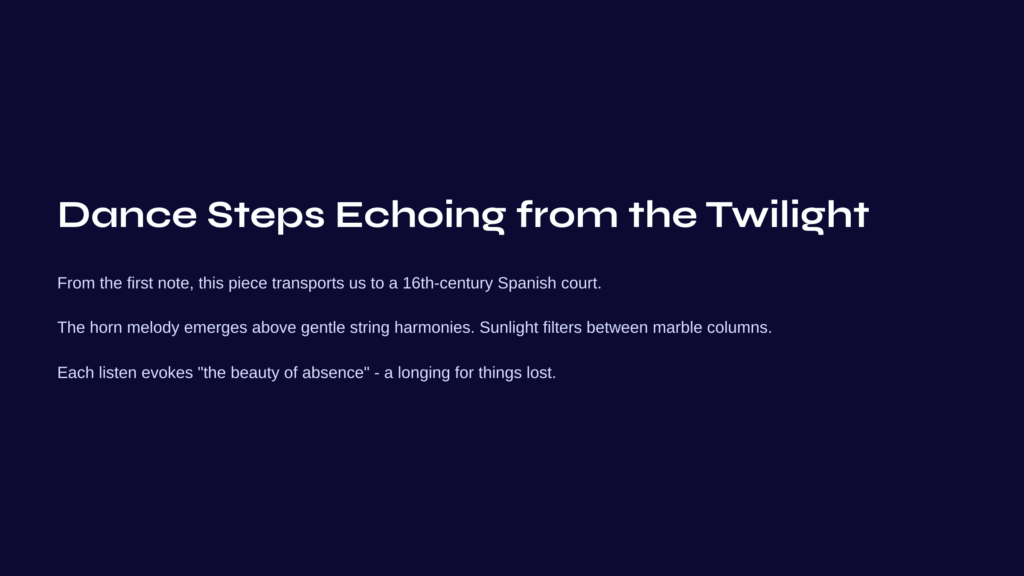
Dance Steps Echoing from the Twilight
Some music transports us to another time and space from the very first note. Ravel’s Pavane for a Dead Princess is precisely such a piece. The moment the horn melody emerges above the gentle harmonies woven by the strings, I find myself walking through the corridors of a 16th-century Spanish court. Sunlight filters between marble columns, and somewhere in the distance, I can almost hear the footsteps of a little princess.
Each time I listen to this piece, what comes to mind is “the beauty of absence.” As the title suggests, there’s a longing for things already lost, a nostalgia for time that can never return, and for just over six minutes, these feelings wash over our hearts. Though Ravel claimed he wasn’t mourning any specific princess, the music itself has become a perfect requiem.
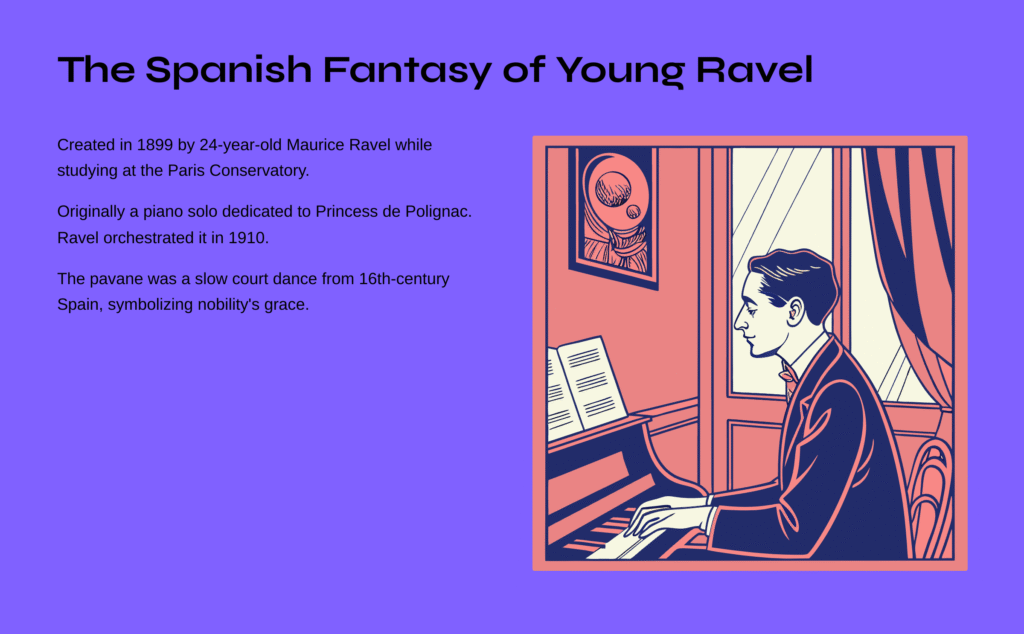
The Spanish Fantasy of Young Ravel
Born in 1899, when the 24-year-old Maurice Ravel was studying composition with Gabriel Fauré at the Paris Conservatory, this work stands as one of the composer’s early masterpieces. Originally dedicated to Princess de Polignac as a piano solo, it gained even deeper colors when Ravel himself created the orchestral version in 1910.
The pavane was originally a slow court dance performed in 16th and 17th-century European palaces. Originating in Spain, this dance symbolized the dignity and grace of the nobility. Ravel borrowed this ancient dance form and reborn it with his own impressionistic palette. Interestingly, the composer confessed that “the title was chosen simply because it sounded good,” drawn to the alliterative beauty of the French words “infante défunte” (dead princess).
After Spanish pianist Ricardo Viñes premiered it in Paris in 1902, the piece gained explosive popularity. Ravel’s affection for Spanish sentiment would later continue through works like the Spanish Rhapsody and Bolero, but the Pavane can be seen as the starting point of this journey.
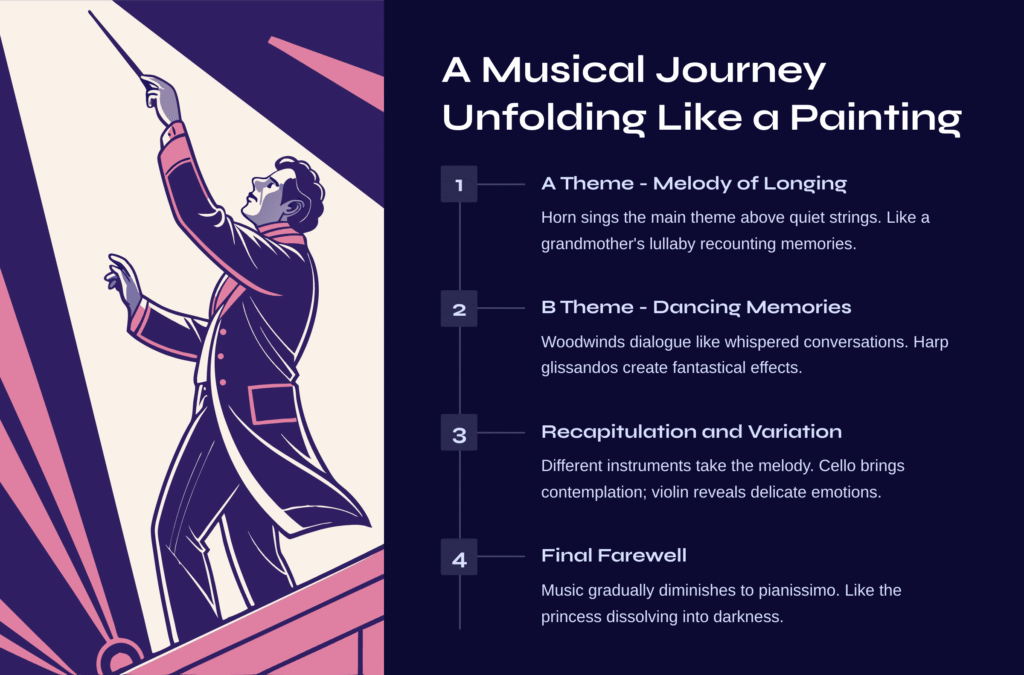
A Musical Journey Unfolding Like a Painting
This piece is structured in rondo form (ABACA), where themes return like scenes in a memory, each time appearing in slightly different guises, as if the same moment in recollection takes on new forms with each return.
A Theme – The Melody of Longing Above the quiet accompaniment of strings, the horn sings the main theme. This melody is like a grandmother’s lullaby, recounting memories from long ago. Within the warmth of G major, subtle dissonances create not simple happiness, but a wistful yearning. The horn’s characteristic golden timbre perfectly recreates the atmosphere of a palace corridor at sunset.
B Theme – Dancing Memories A dialogue begins between the woodwinds. Flute and oboe respond to each other like whispered conversations between court dancers. Here, the harp’s glissando creates a fantastical effect, as if veils of time are gently being drawn aside. The pavane’s characteristic slow triple meter creates a rhythm that suggests a stately yet graceful gait, neither heavy nor hurried.
Recapitulation and Variation – Fading Shadows Each time the theme returns, different instruments take the melody. When the cello sings, deeper contemplation emerges; when the violin takes over, more delicate emotions are revealed. Ravel precisely utilizes each instrument’s unique timbre, making the same melody sound different with each appearance.
Final Farewell – Into Silence In the piece’s conclusion, the music gradually diminishes, fading away to pp (pianissimo). Like the princess’s figure dissolving into darkness, or like awakening from a dream, the music ends. This conclusion is not a dramatic finale but a natural dissolution—everything returning to the silence from which it came.
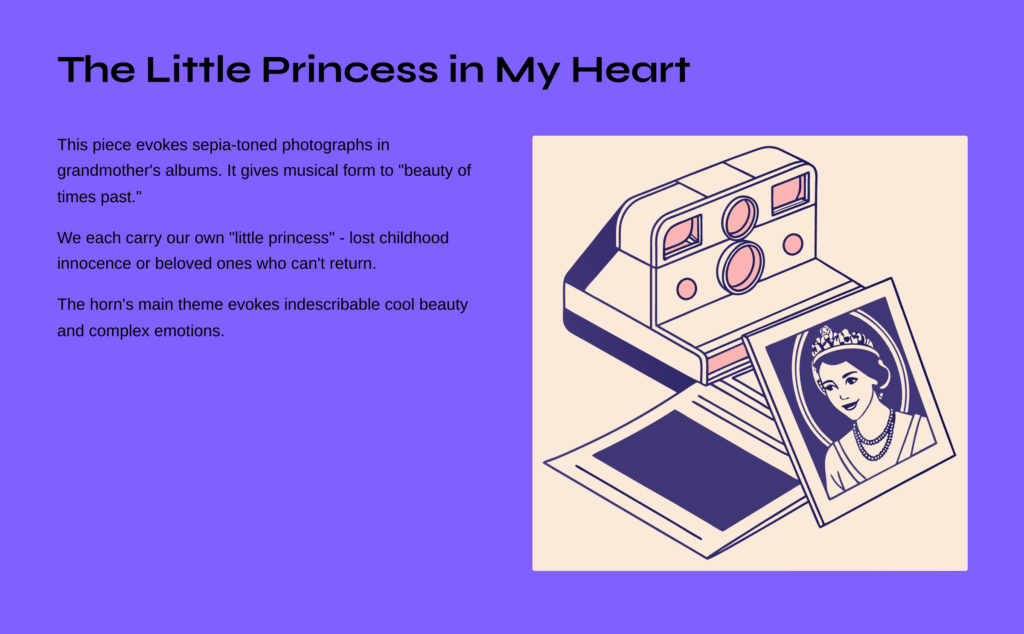
The Little Princess in My Heart
Every time I hear this piece, I’m reminded of old photo albums I used to look through at my grandmother’s house as a child. The expressions of people in sepia-toned photographs, their clothing, the weight of the era they lived in. The Pavane is a work that gives musical form to this “beauty of times past.”
Though Ravel said he had no specific princess in mind, don’t we each carry our own “little princess” in our hearts? The lost innocence of childhood, beloved ones who can never return, or perhaps the disappointment when our dreams didn’t become reality. All of these are sublimated into beautiful memory within Ravel’s melodies.
Particularly when the horn’s main theme first appears, the cool beauty it evokes is indescribable. Complex emotions that can’t be called simply sad or beautiful sweep through the heart. This is perhaps the power of impressionist music—instead of injecting specific emotions, it allows listeners to discover their own feelings.
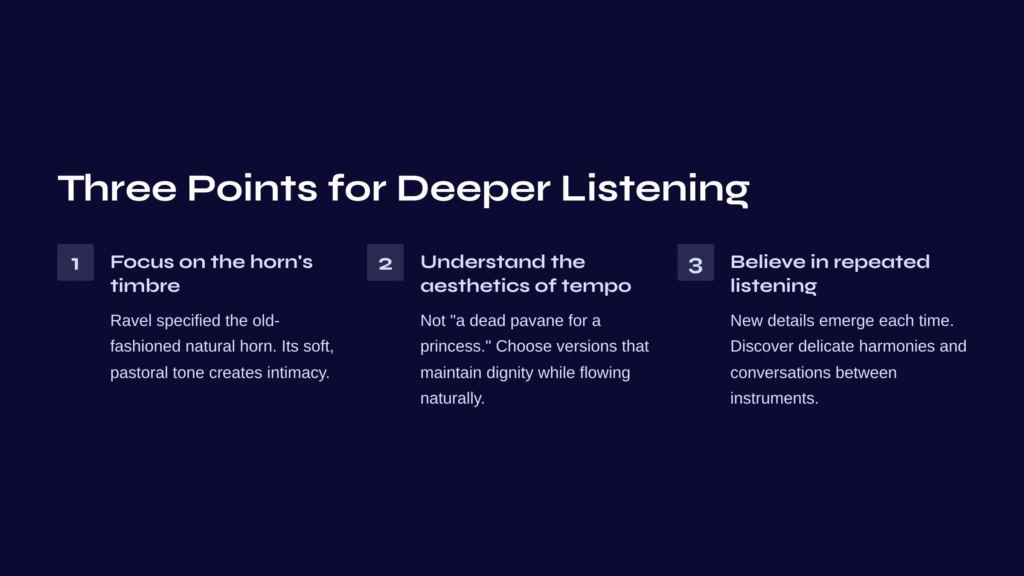
Three Points for Deeper Listening
First, focus on the horn’s timbre In the orchestral version, Ravel deliberately specified the old-fashioned natural horn without valves. The characteristic soft, pastoral tone this instrument produces determines the entire piece’s atmosphere. Each time the horn melody appears, feel those subtle timbral changes. There’s an intimacy, as if someone is whispering old stories directly into your ear.
Second, understand the aesthetics of tempo Ravel warned against overly slow performances. He joked that it wasn’t “a dead pavane for a princess.” Too fast and the elegance disappears; too slow and it becomes tedious. It’s important to choose a version performed at a tempo that maintains the dignity of court dance while flowing naturally.
Third, believe in the value of repeated listening This isn’t music to be heard once and forgotten. New details are discovered with each listening. Initially, only the main melody catches the ear, but gradually you can hear the delicate harmonic progressions in the accompaniment and the subtle conversations between instruments. The reason it never becomes boring, even after multiple hearings, lies in Ravel’s precise orchestration.
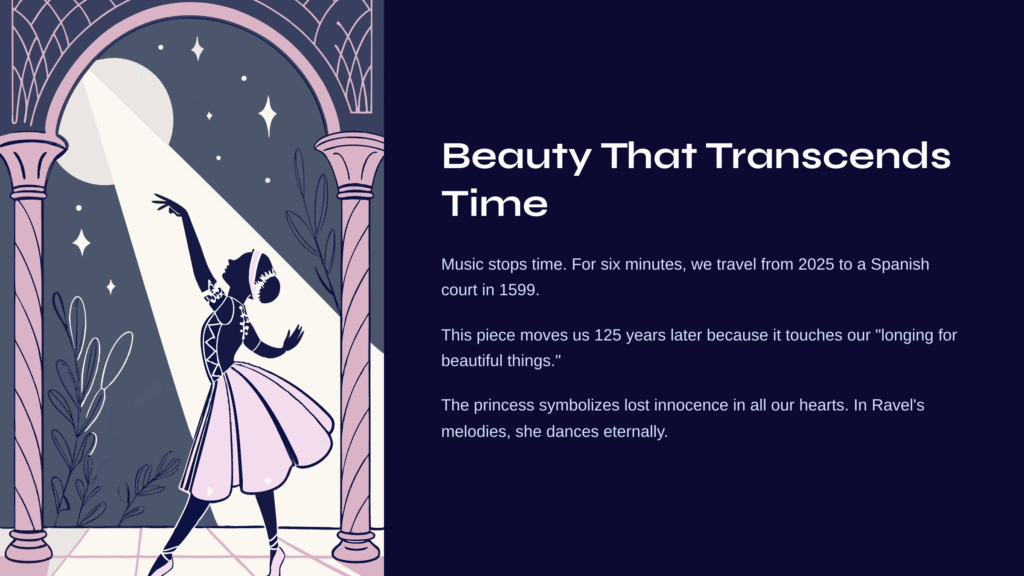
Beauty That Transcends Time
Music has the power to stop time. During the six minutes of listening to Pavane for a Dead Princess, we travel freely from our present in 2025 to a Spanish court in 1599, and then to the most precious moments within our own hearts.
Why does this work, written by the 24-year-old Ravel, still move our hearts 125 years later? It’s because this music touches something beyond any specific era or individual story—the “longing for beautiful things” that every human being carries within.
The little princess of the Spanish court is ultimately a symbol of the lost innocence that lives in all our hearts. She hasn’t died. She has simply disappeared beyond time, allowing us to long for her. In Ravel’s melodies, she dances eternally, and we can join that dance whenever we wish.
The lingering resonance that remains in our hearts long after the music ends and the final note fades away—that is the greatest gift that Pavane for a Dead Princess offers us.
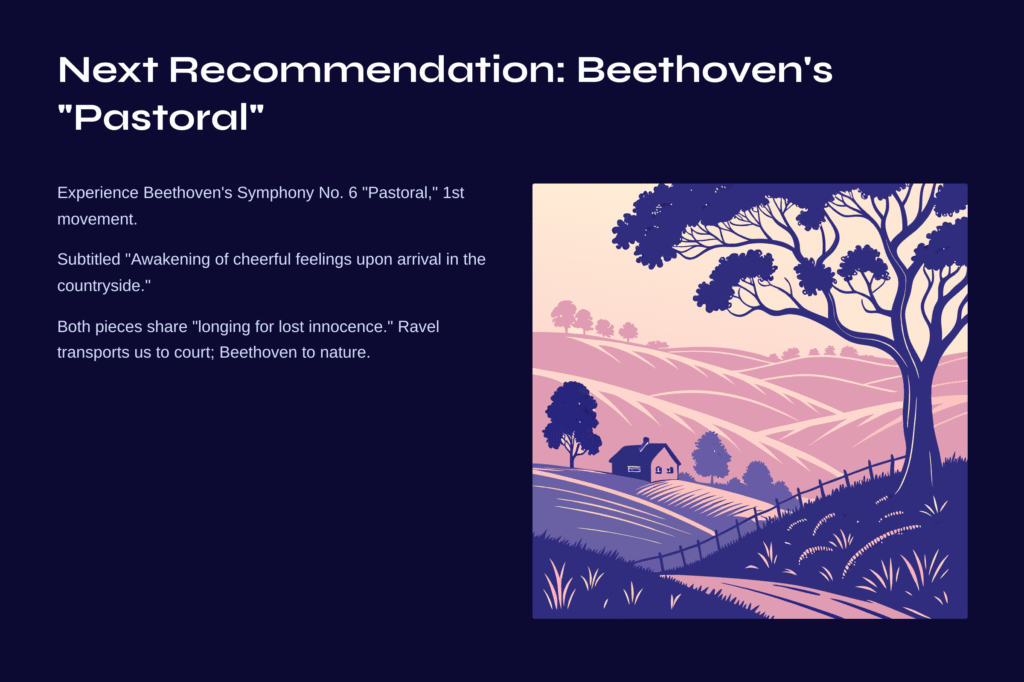
Next Recommendation: Beethoven’s Symphony No. 6 “Pastoral”, 1st Movement
If you wish to experience more deeply the timeless beauty and natural lyricism felt in Ravel’s Pavane, I recommend Beethoven’s Symphony No. 6 “Pastoral,” 1st movement. Subtitled “Awakening of cheerful feelings upon arrival in the countryside,” this movement sings of the peaceful joy felt when escaping urban bustle for nature’s embrace.
Though it offers a different kind of beauty from Ravel’s courtly elegance, both pieces share the common thread of “longing for lost innocence.” While the Pavane transports us to a Spanish court of the past, Beethoven’s “Pastoral” 1st movement guides us to the primordial tranquility offered by mountains and fields. Particularly when the first theme is presented by the violins, that simple yet profound emotion creates a fascinating contrast with Ravel’s horn melody.
Listening to both pieces in succession, you can experience those moments when music transcends era and borders to touch the purest regions of the human heart.
